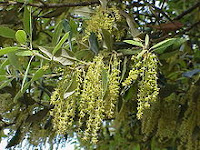INTELLECT TREE, BLACK-OIL PLANT, CLIMBING STAFF VINE, CELASTRUS PANICULATUS
This plant is a climbing vine, with white flowers which give way to seeds surrounded by red or orange yellow arils, (succulent seed coats) and it is the seeds which are used in Unani (Greek) medicine and Ayurvedic medicine on the Indian subcontinent. The seed coats are wrinkled, and the seeds have an unpleasant smell, but are used for most ailments, as well as being thought of as an aphrodisiac.
 Externally the seeds are used for putrid ulcers, leprosy and scabies. They are also used to treat beriberi which is a vitamin B1 deficiency, caused by a lack of the B-complex vitamin, thiamin.
Externally the seeds are used for putrid ulcers, leprosy and scabies. They are also used to treat beriberi which is a vitamin B1 deficiency, caused by a lack of the B-complex vitamin, thiamin. This plant has been associated with helping memory loss and sharpening the intellect for thousands of years and has been given to many generations of lawyers and students throughout the ages. It grows extensively in the Indian subcontinent and the Andaman Islands .
The oil from its seeds is also used in medicine, sometimes as a stimulant. However, it also has sedative properties and these have been shown in a study on rats. The seeds contain what are at the moment unique constituents and have been the object of scientific studies. In 2004 in the August edition of the “Journal of Ethnopharmacology” the researchers comment that the seeds ability to improve memory loss may be due to their “neuroprotective” actions.
 A later study published in the Journal of Pharmaceutical Science and Technology Vol. 2 (2) 2010 by George Lekha et al found that “…the plant seed oil may be more effective in individuals who are cognitively impaired as a result of chemical or organic brain damage as compared with normal subjects.” In other words it could help Alzheimer’s sufferers more than the vast majority. This study also seemed to show that the seed oil can relieve stress, but more research is necessary before any of the finding can be translated into positive help for people who are suffering from the memory loss associated with the aging process.
A later study published in the Journal of Pharmaceutical Science and Technology Vol. 2 (2) 2010 by George Lekha et al found that “…the plant seed oil may be more effective in individuals who are cognitively impaired as a result of chemical or organic brain damage as compared with normal subjects.” In other words it could help Alzheimer’s sufferers more than the vast majority. This study also seemed to show that the seed oil can relieve stress, but more research is necessary before any of the finding can be translated into positive help for people who are suffering from the memory loss associated with the aging process. In other studies it has been found that the seed oil can halt convulsions and can reduce the heart rate. However there have been no studies on human subjects.
In other studies it has been found that the seed oil can halt convulsions and can reduce the heart rate. However there have been no studies on human subjects. The leaves from this plant are boiled and eaten as a vegetable to relieve the painful symptoms of menstruation, but the parts of the plant most widely used in traditional medicines are the seeds and the seed oil.
Clearly this is another plant which could help us in the fight against the symptoms of Alzheimer’s and other diseases which diminish our cognitive powers. It is a wonderful thought that we have an “Intellect” tree.



































